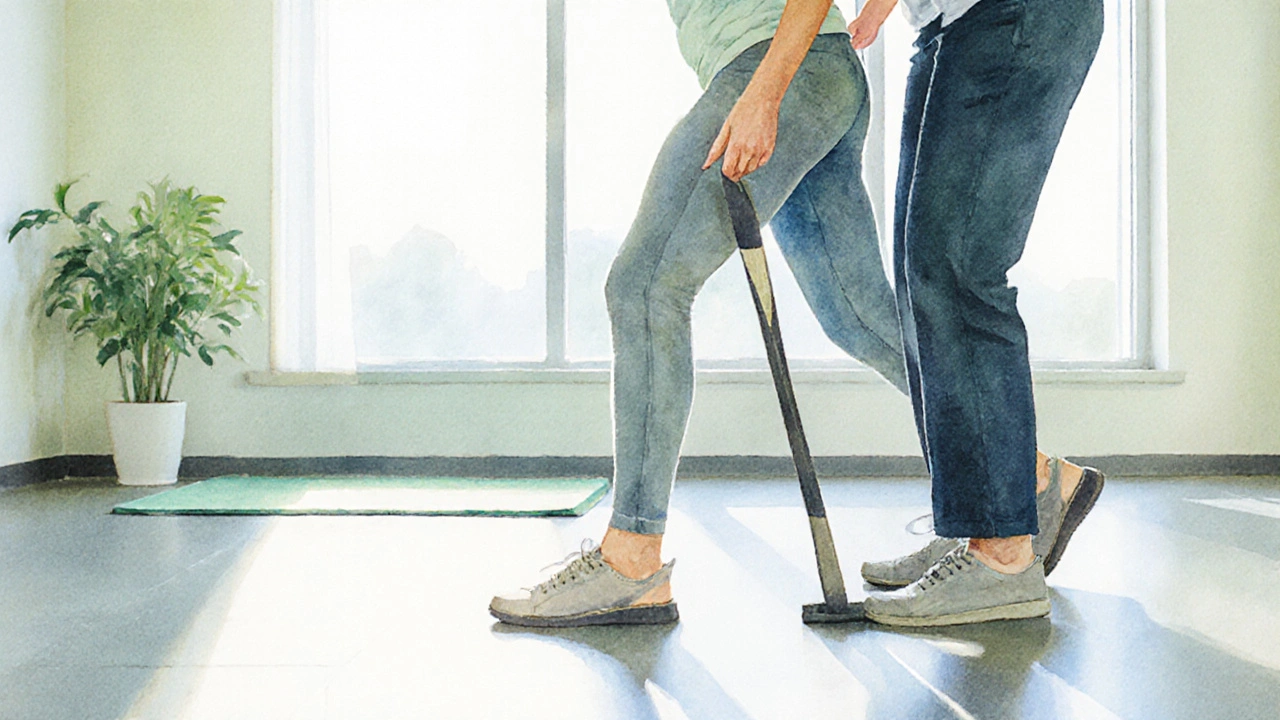Balance Exercise Progress Tracker
Your improvement rate based on symptom logs
Safety Reminder
Always complete exercises near a stable surface. Stop immediately if you experience:
- Vertigo lasting more than 1 minute
- Severe nausea
- Worsening tinnitus
If symptoms persist, sit down and rest with eyes closed until they subside.
Quick Takeaways
- Targeted balance exercises can reduce dizziness episodes for people with Meniere's disease.
- Start with low‑impact movements and progress gradually under professional guidance.
- Combining vestibular rehabilitation therapy with daily stability drills yields the best results.
- Monitor symptoms; stop any exercise that provokes severe vertigo or nausea.
- Regular reassessment helps keep the program safe and effective.
Understanding the Challenge
When dealing with Meniere's disease is a chronic inner‑ear disorder that causes episodes of vertigo, hearing loss, tinnitus and a feeling of fullness in the ear, balance problems quickly become a daily concern. The condition stems from a buildup of fluid-known as endolymph-in the labyrinth, which disrupts the vestibular system is the network of fluid‑filled canals and sensory organs that tells your brain where your head is in space. When that system misfires, the brain receives mixed signals, leading to unsteady gait and falls.
While medication and dietary changes address the fluid imbalance, they rarely fix the loss of coordination. That’s where targeted balance exercises are controlled movements designed to retrain the brain‑body connection and improve postural stability come in.

Why Exercise Works
Physical activity stimulates the brain’s plasticity, encouraging it to rely more on visual and proprioceptive cues when the vestibular input is unreliable. Over time, this “compensation” reduces the frequency and intensity of dizzy spells. The specific approach used by clinicians is called vestibular rehabilitation therapy (VRT) a series of customized exercises that challenge balance, eye‑head coordination, and gait to restore function. VRT isn’t a one‑size‑fits‑all; it’s tailored to each person’s symptom pattern and severity.
Research published in the Journal of Vestibular Research (2023) showed that patients who performed VRT at least three times a week experienced a 45% reduction in vertigo episodes after eight weeks, compared with a 12% reduction in those who only took medication.
Core Exercises to Boost Stability
Below are six exercises that address the three main pillars of VRT: gaze stability, postural control, and gait training. Perform each movement slowly at first, focusing on smooth, controlled motion. Aim for two sets of 10‑15 repetitions, three times a week.
- Head‑Turn Gaze Stabilization
- Stand or sit with eyes fixed on a small target (a pen tip works).
- Turn your head left‑right at a comfortable speed while keeping the target in focus.
- Start with a 10‑second interval, then increase to 30 seconds as tolerance builds.
This exercise trains the vestibulo‑ocular reflex is the eye‑movement system that stabilizes vision during head motion. If you feel nausea, reduce the speed or shorten the session.
- Standing on One Leg (Romberg Variation)
- Lift one foot off the ground and hold for 15 seconds.
- Progress to eyes‑closed for the final 5 seconds.
- Switch legs and repeat.
This simple drill challenges proprioceptive input and improves the Romberg test is a clinical assessment of balance that involves standing with feet together, eyes closed, and arms at the sides. Consistent practice reduces sway over time.
- Heel‑to‑Toe Walk
- Walk in a straight line, placing the heel of one foot directly in front of the toe of the other.
- Take 20 steps forward, then turn around and repeat.
This gait exercise reinforces gait training is the practice of walking patterns to improve coordination and safety. It’s especially useful for patients who feel unsteady on uneven surfaces.
- Side‑Stepping with Resistance Band
- Place a light resistance band just above your knees.
- Step sideways against the band's tension, 10 steps each direction.
Strengthening the hip abductors supports lateral stability, a common weak point in inner ear disorders conditions that affect the cochlea and vestibular apparatus.
- Tai Chi “Weight Shifting”
- From a relaxed standing position, slowly transfer weight from one foot to the other while keeping knees slightly bent.
- Repeat for 2 minutes, breathing gently.
Tai Chi’s slow, flowing movements improve balance without provoking vertigo. A 2022 meta‑analysis found a 30% drop in fall risk among seniors practicing Tai Chi twice weekly.
- Supine Leg Lifts (Core Stabilizer)
- Lie on your back, knees bent, feet flat.
- Lift one leg to a 45° angle, hold for 5 seconds, lower slowly.
- Do 10 reps per side.
Core strength supports the spine and improves overall postural control, which reduces the brain’s reliance on faulty vestibular signals.
Safety First: Managing Symptoms While Exercising
Even gentle drills can trigger a vertigo bout. Follow these guidelines to keep sessions constructive:
- Start low, progress slowly. Begin with 5‑minute sessions; increase duration only when you feel comfortable.
- Use a stable support. Perform standing moves near a sturdy chair or countertop.
- Stay hydrated and avoid heavy meals at least an hour before exercising, as a full stomach can exacerbate nausea.
- Track your symptoms. Keep a simple log noting time, exercise, and any dizziness or tinnitus flare‑ups.
- Know when to stop. If spinning lasts longer than a minute or you feel disoriented, sit down, close your eyes, and breathe slowly.

Building a Sustainable Routine
Consistency beats intensity for vestibular rehab. Aim for a 30‑day plan:
- Week1: Perform the six core exercises three times a week, 10‑minute sessions.
- Week2: Add a second daily session (morning/evening) and incorporate the Tai Chi flow twice weekly.
- Week3: Increase each standing exercise by 5 seconds; introduce light ankle weights for the side‑stepping set.
- Week4: Evaluate progress with a simple balance test (stand on one leg eyes closed for 20 seconds). If you’ve improved, maintain the routine; if not, consult a vestibular therapist for adjustments.
Remember, the goal isn’t to eliminate every dizzy spell but to reduce how often they interrupt daily life.
When Professional Help Is Needed
If you notice any of the following, book an appointment with an ENT specialist or a physiotherapist trained in vestibular rehabilitation:
- Vertigo lasting more than 30minutes per episode.
- Sudden loss of hearing or worsening tinnitus.
- Frequent falls or a noticeable decline in walking confidence.
- Exercise‑induced nausea that doesn’t subside within a few minutes.
Therapists can tailor VRT to your specific pattern of symptoms, introduce advanced tools like balance boards, or combine therapy with dietary sodium restriction for optimal fluid management.
Frequently Asked Questions
Can I do these exercises at home without equipment?
Yes. Most of the core drills use only body weight or simple household items like a chair. A light resistance band is optional but adds extra challenge.
How long before I notice improvement?
People typically report a noticeable reduction in dizziness after 4‑6 weeks of regular practice, though individual results vary.
Is it safe to combine these exercises with medication?
Generally, yes. Most vertigo medications do not interfere with balance drills, but always check with your doctor, especially if you’re on diuretics or anti‑histamines.
What if I experience a sudden spike in tinnitus during an exercise?
Stop the activity, sit down, and focus on deep breathing. If the ringing persists for more than 30 minutes, contact your ENT specialist.
Are there apps that guide vestibular rehab?
Yes. Apps like "VRT Coach" and "Balance Rehab" provide video demos, timers, and symptom logs that can complement a therapist‑driven program.

Ever notice how the health industry loves to push pricey gadgets while the simplest balance drills are right under your kitchen chair? 👀 The vestibular system is basically a tiny fluid tank that can be retrained with gentle head‑turn gaze work, so you don’t need a fancy balance board to keep the inner ear happy. Start with the Head‑Turn Gaze Stabilization exercise for just ten seconds, then slowly stretch to thirty as your tolerance builds. 👍 Adding a daily log of dizziness intensity helps you spot subtle improvements that might otherwise slip by unnoticed. Remember to keep a sturdy surface nearby – a coffee table or sturdy chair is your safety net if vertigo tries to hijack the session. If you ever feel a wave of nausea lasting more than a minute, stop, sit down, and breathe deep; the brain will reset its signal map. Consistency beats intensity every time – three short sessions per week are more effective than one marathon workout. Over weeks, your brain will lean more on visual and proprioceptive cues, diminishing the reliance on faulty vestibular input. Some folks think the meds are all you need, but combining medication with these exercises can cut vertigo episodes by nearly half, according to recent studies. Keep your eyes on a fixed point while you turn your head, and you’re training the vestibulo‑ocular reflex – the very link that stabilizes vision during motion. 🎯 Don’t be afraid to adjust the speed; slower movements are just as beneficial and less likely to trigger symptoms. Hydration matters too – a well‑hydrated system processes inner‑ear fluid more efficiently. If you ever feel like your tinnitus spikes during a drill, pause and give your ears a break; it’s a normal sign that the auditory pathways are being challenged. The beauty of this regimen is that you can do it in a living‑room, a backyard, or even a quiet office break room. 🌿 Finally, celebrate each tiny victory – standing a second longer on one leg is progress, not a failure. Keep logging, keep moving, and let your brain rewire itself one gentle motion at a time. 🙌
Look, if you think sprinkling a few simple moves on a page makes you a vestibular guru, you’re missing the point. The real issue is that most of these "exercises" are marketed to the masses without any real scientific backing – just a way for the industry to sell more "premium" rehab programs. Sure, turning your head while looking at a pen might feel nice, but without proper assessment you could be doing more harm than good. And don’t get me started on the vague advice about “stable surfaces” – you could be standing on a wobbly coffee table and still call it safe. Bottom line: if you’re serious, see a legit therapist, not a random blog post.
Friends, the steps outlined here align well with the principles of vestibular rehabilitation therapy. Consistency, gradual progression, and careful symptom monitoring are crucial. By focusing on gaze stability first, the visual‑vestibular coupling improves, which then supports balance tasks like single‑leg stance. Encourage patients to keep a simple log – the data often reveal patterns that guide the next phase of training. Remember, the goal is not to eradicate every vertigo episode, but to reduce its impact on daily life.
Interesting.
Let’s be clear: balance work is for everyone, regardless of age or ability. If you feel hesitant, start near a sturdy chair, breathe, and trust the process. Push yourself a little each session – that’s how neuroplasticity happens. No excuses.
Hey all! 🌟 I’ve been trying the Tai Chi weight‑shifting for a few weeks and it’s honestly a game‑changer. It feels so gentle on the ears but still gives a solid core workout. Pair it with the heel‑to‑toe walk on a carpeted floor and you’ll notice your gait smooth out. Keep logging those dizziness scores – it’s awesome to see the numbers drop! Stay positive and keep moving. 😊
Nice tip. I add a quick 30‑second single‑leg hold after my morning stretch. Works well.
Listen, if you wanna keep America strong we need to push these rehab protocols in the VA hospitals, not just hand‑out pamphlets. The real strength comes from disciplined, regimented training - not some vague “do it at home” nonsense. Get the tough‑love approach, push the limits, and you’ll see real gains.
Curious about how the vestibular system recalibrates after repeated drills 🤔🧠. Does anyone have data on the minimum weekly frequency needed for measurable improvement? Also, love the suggestion to use a simple log – makes tracking feel like a game! 😄
What a brilliant synthesis of evidence‑based practice! 🎓 The linkage between gaze‑stabilization and the vestibulo‑ocular reflex is expertly highlighted, and the step‑by‑step progression respects the neuroplastic window for adaptation. I would add a brief note about the role of otolithic modulation during head‑tilt tasks – a subtle but powerful adjunct for those with lingering positional vertigo. Moreover, the recommendation to incorporate a symptom journal not only quantifies progress but also empowers patients to become active participants in their recovery. This patient‑centric approach is precisely what our field needs to move beyond the one‑size‑fits‑all paradigm.
Honestly, these exercises sound like a lot of fluff. I’ve tried a couple of the listed drills and didn’t notice any change in my dizziness. Maybe it works for some, but it feels overrated.
Overrated? More like basic. If you’re not seeing improvements, you’re either not following the protocol strictly or you lack the discipline to push through the discomfort. Stop making excuses and commit to the regimen.
Just tried the side‑stepping with a band – felt a nice burn in the hips. 👍 Simple but effective.
Imagine the inner ear as a tiny orchestra, each canal a different instrument. When the fluid dynamics go off‑beat, the whole symphony falters, leading to that disorienting vertigo. By engaging in structured, rhythmic movements – think of them as a conductor’s baton – you gently coax the orchestra back into harmony. The elegance lies in the simplicity: a slow head turn, a deliberate step, a mindful breath. These acts are not merely physical; they are a dialogue with the body's deeper sensory architecture, inviting balance to re‑emerge like sunrise over a calm sea.
First, let us acknowledge the sheer complexity of the vestibular apparatus-an intricate network of semicircular canals, otolith organs, and neural pathways that together orchestrate equilibrium. ;;;; Second, the presented regimen, while laudable, appears to suffer from a paucity of individualized calibration, thereby risking a one‑size‑fits‑all approach; however, the inclusion of symptom logging offers a modicum of personalization. ;;; Third, the integration of Tai Chi weight‑shifting is commendable, given its low‑impact nature and historical efficacy in fall prevention; nevertheless, practitioners must remain vigilant for latent proprioceptive deficits that could be exacerbated by insufficient support structures. ;;; Finally, the recommendation to progress from five‑minute sessions to longer intervals should be governed by patient‑specific thresholds, not arbitrary timelines. In sum, the protocol is a solid foundation, yet warrants nuanced adaptation.
Technically, the vestibulo‑ocular reflex can be conditioned through repetitive gaze‑stabilization exercises; however, the efficacy is contingent upon the precise angular velocity and amplitude of head movements. Empirical data suggest a minimum of 15‑minute daily exposure for statistically significant desensitization of the symptomatology. Ignoring these parameters leads to suboptimal outcomes.
Great info! 😊 I’m planning to start with the single‑leg stand tomorrow – can’t wait to see the improvement. Let’s keep each other motivated! 🌟
i think this whole balancce thing is overhyped. soo much for a pep talk. i guess some peopl could benefit but not evryone. lets see how it goes.